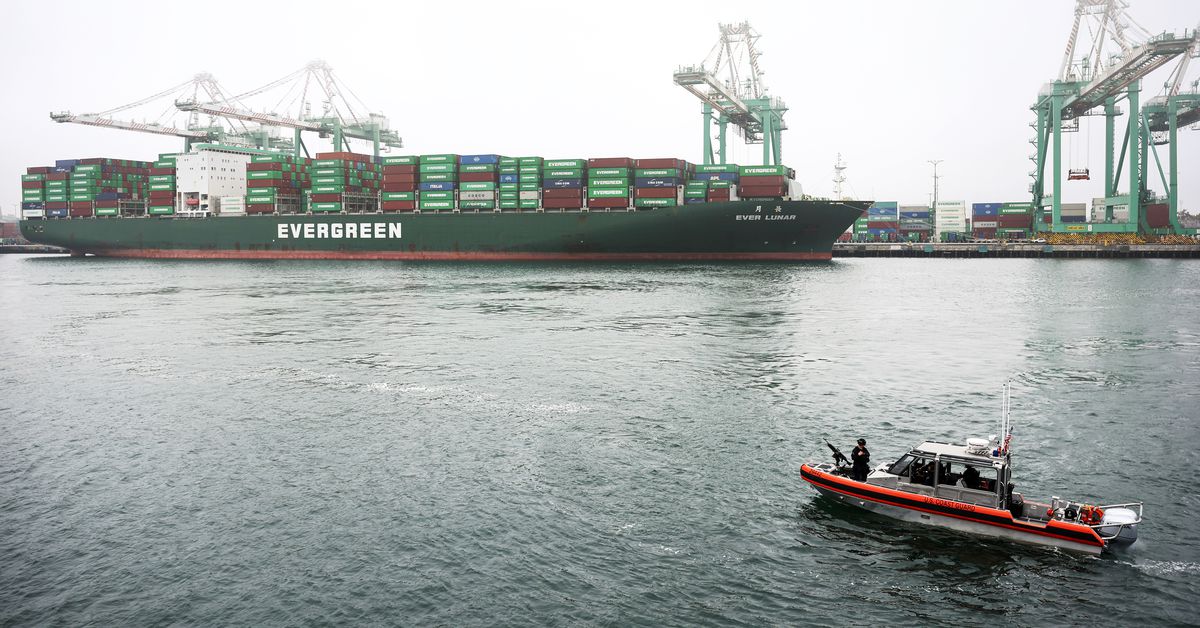
Everything from children’s toys and furniture to guacamole has gotten more expensive, so it’s not surprising that inflation is top of mind for many Americans. But with the midterm elections drawing closer — and Republicans hammering the White House about rising consumer prices — President Joe Biden thinks voters should direct their frustrations elsewhere. He says they should be angrier at a critical, but often forgotten, part of the US economy: the ocean shipping industry.
“There are nine — nine — major ocean line shipping companies that ship from Asia to the United States. Nine. They form three consortia. These companies have raised their prices by as much as 1,000 percent,” Biden declared in a speech at the Port of Los Angeles, the country’s largest port, in June. “There’s no better place to start it than right here in the port, and letting those nine foreign shippers understand the rip-off is over.”
Right now, the cost of sending goods across the Pacific is still more expensive than it was before the pandemic. This price surge is a product of not only the delays and bottlenecks in the supply chain created by Covid-19 but also the huge increase in demand for consumer goods that followed. This demand was far greater than what shipping companies or American ports could handle. As a result, the price of shipping went up, creating increases in costs for importers and retailers within the United States. Those costs have now been passed on to consumers, which is partly why many everyday items are more expensive lately. (Surging gas prices, the war in Ukraine, and pandemic-era financial policies may also be driving inflation.)
Experts told Recode it’s unlikely that Biden’s crackdown on the shipping industry will significantly reduce the cost of products, even if it will make some meaningful improvements to operations at America’s ports. The small group of companies that dominate the shipping industry remain extremely powerful: They still benefit from longtime exemptions from antitrust laws and continue to wield enormous power.
The situation serves as a reminder that, while specific segments like the ocean shipping industry can play a massive role in influencing the prices of everyday goods, they’re also participating in the much larger economic system of supply and demand. This system involves everyone from the companies that build ocean vessels that shipping companies use to parents desperately trying to buy Barbie Dreamhouses for their kids. This complexity can make price increases extremely hard to rein in, even if you’re the president.
Ocean shipping, explained
By design, the shipping industry isn’t supposed to have a significant impact on the price of everyday goods. Many companies make their products outside the United States, in places where manufacturing is cheaper. This approach only makes economic sense if these companies know they can ship finished goods to their customers at a low cost.
This is where the major ocean carriers come in: Nine companies, including firms like Maersk, Cosco, and Hapag-Lloyd, handle the vast majority of shipping across the Pacific Ocean. These companies have been granted limited immunity from certain antitrust laws, and form powerful shipping alliances that coordinate on routes and even share their vessels. A single ship can stretch hundreds of meters long, and some can carry more than 20,000 shipping containers. These ships may travel between ports in several countries, picking up raw materials, parts, supplies, and finished products throughout their route on behalf of different carriers.
To make sure these ships are filled to the brim, carriers play their own version of Tetris. Because carriers share their vessels, several companies can sell transportation services on the same ship. Companies have to figure out which shipping containers should go where, based on where they’re coming from and where they’re going. Once cargo arrives at its destination, powerful cranes lift these containers from ships so they can be loaded onto trucks and trains traveling inland, and quickly fill the open space on the ship with a new container. Normally, this makes international freight shipping a skillfully choreographed operation, one that has made sending an item across the Pacific a negligible part of the cost of many products we buy every day.
But then came the pandemic. Factories, understandably, closed because of Covid-19, and that created manufacturing delays, threw schedules off course, and ultimately led to shortages of all sorts of products. The pandemic also meant that people spent more time at home, stopped buying services, and cut back on travel. As a result, they started to spend a lot more on consumer goods, goods that typically needed to be shipped to the US from abroad, primarily from countries in Asia. Shipping became harder to provide and much more in demand — which sent shipping prices skyrocketing.
Now these shipping companies are facing a lot more scrutiny as well as growing concern that they’ve used their longtime antitrust immunity to profit during a crisis. Before the pandemic, these carriers had an average operating margin of just under 4 percent, but during the third quarter of last year, that margin grew to more than 50 percent. This has made importing goods in the US much more expensive: At the end of June, it costs nearly $7,600 to rent a 40-foot shipping container traveling across the Pacific compared to about $1,300 in early 2020, according to one shipping industry index.
“Today, the top nine companies control 85 percent of the trade. Go back 15 years ago, the top 10 companies controlled 50 percent of the trade. They basically ran companies out of business and bottom up,” Sal Mercogliano, a maritime history professor at Campbell University, said. “They were in a pretty vicious rate war, and then all of a sudden Covid happens and rates go through the roof.”
Importers and exporters have also accused these shipping companies of taking advantage of supply chain chaos, which has left them paying exorbitant detention and demurrage fees — fines charged to shippers that don’t pick up and drop off containers on time. Normally, these fees act as an important incentive to make sure shipping stays on schedule, but some logistics companies and importers say that the ocean carriers have made it almost impossible for them to pick up and drop off cargo on time. And ultimately, the cost associated with paying the fees gets passed on to customers.
The cost of shipping is coming down
Inflation isn’t something the president directly controls, and it’s not something that can easily be fixed. Meanwhile, most Americans say the top problem facing the country is rising consumer prices, which means it’s all but certain to become a major issue in the upcoming midterm elections. These elections will determine whether Democrats retain control of the House and the Senate, and will shape what Biden will be able to accomplish in the second half of his presidential term.
With voters acutely aware of the issue, the president is looking to cast the blame for inflation on entities far away from the White House. In this case, he’s pointing a finger at the small but powerful group of international companies that control shipping in the Pacific. Biden also wants to appear to be taking action on the problem, especially since it’s one that consumers notice in their everyday purchases.
“We have socks and plastic buckets, and things like that, being shipped around the world because it costs next to nothing to ship them,” Marc Levinson, a historian of the container shipping industry, explained. “Now, if the cost of shipping for a pair of shoes has gone up from 10 cents to 50 cents, that can actually be significant because there will be a further markup at every stage along the supply chain.”
Enter the Ocean Shipping Reform Act, which the president claims will lower costs and help fight inflation. The law, which was signed by Biden in June, empowers the Federal Maritime Commission, the agency that regulates shipping into the US, to investigate carriers’ practices and help craft new rules. The government will also create a more formalized way to track chassis, the metal frames that are used to carry shipping containers at the ports, and expand the commission’s powers when the ports are extremely congested. Finally, the law targets the increasingly common practice of ocean carriers transporting empty containers back across the Pacific instead of waiting to fill their cargo with American exports, including agricultural products that American farmers have sold to customers in Asia.
While all of these measures sound like progress, there’s no guarantee they will do much to lower prices overall. Again, many other factors are also driving inflation.
“It’s not like furniture is suddenly going to be cheaper overnight, right away. That’s not the way the system works, and frankly, it’s not the way the economy works,” Daniel Maffei, the chair of the Federal Maritime Commission, said. “Everybody would like a silver bullet to inflation.”
The Ocean Shipping Reform Act does set the groundwork for addressing growing concerns that carriers are engaging in harmful, anti-competitive behavior. (A recent investigation by one of the agency’s commissioners found no evidence of illegal behavior or collusion that had contributed to high shipping prices.) The legislation comes as the FMC ramps up its efforts to investigate carriers, including a push to crack down on unfair fees that the commission began last year, and a new partnership with the Justice Department announced in February.
But the law, which was not as aggressive as another proposal in the House, doesn’t change the fact that shipping is still dominated by just three alliances, despite mounting calls to curtail their power. Nor does it give the FMC the ability to set the price of shipping. Perhaps most importantly, it doesn’t deal with one of the primary issues that drove the high cost of shipping: surging demand for products that need to be shipped. Gene Seroka, the executive director of the Port of Los Angeles, told Recode that whether the legislation would help lower prices is “to be determined.”
“Declining demand will help,” Willy Shih, a management professor at Harvard Business School, said. “If we go into a recession, then demand will drop and then that’ll give everybody time to catch up, and even things out more.”
The global supply chain is made up of many different countries, companies, and people, which means that the price of a single good is influenced by myriad factors that are incredibly hard to control. That means that, for now, you shouldn’t expect Joe Biden’s mounting effort to regulate the shipping industry to have an immediate impact on the price of the stuff you buy.
In reality, the best way to lower the cost of shipping is for people to stop buying so many things that need to be shipped. Given that the economy doesn’t seem to be in a great place right now, that just might happen sooner rather than later. For what it’s worth, imports to the US seem to be declining, and American consumers appear to be returning to their pre-Covid spending habits.






